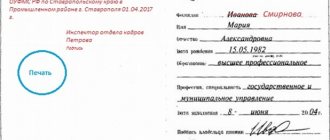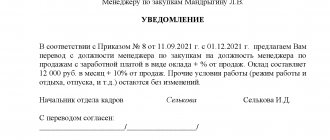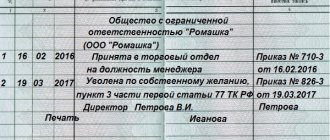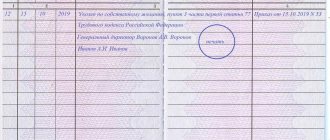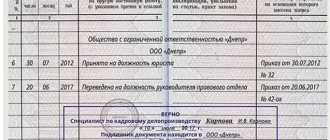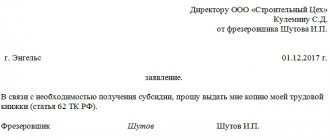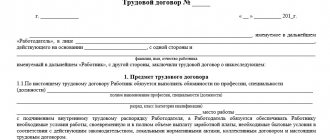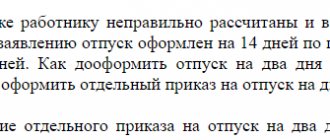The work book records almost all information about a person’s work activity throughout his life. The accrual of a pension to the employee in the future largely depends on the correctness of its completion, so the personnel officer needs to be extremely careful when entering information. If it is necessary to correct the date of dismissal in the work book, a sample of such an entry should be based on Instruction No. 69, published in 2003, and Rules No. 225 of the Ministry of Labor. These regulatory documents spell out in detail how to correct such an inaccuracy if it was made.
How to correctly make corrections to a work book
If errors are found in the work book, the employee draws up and submits an application to the director of the enterprise to correct the entry.
If at the time of discovery of an erroneous entry a citizen is unemployed, he contacts the personnel department of his last place of work to correct the error. This rule is valid regardless of the period of dismissal.
Incorrect entries in the work book are neatly crossed out with one line. New data is written above, below, or on the same line. The crossed out entry must be easy to read. Explanations and a link to the documents on the basis of which the changes were made are left on the inside cover.
Is it possible to correct the entry in the labor record?
The work book is the main document confirming the employee’s work experience.
Erroneous entries can significantly hinder you in the future, especially if you often change jobs during your career.
When assigning a pension, if errors are found in several entries, he will have to run a lot to restore the true dates of admission, dismissal, or even confirm that the work book belongs to him if there are errors in the spelling of the first name, patronymic, and last name.
All corrections in the work book are permissible, according to Art. 66 of the Labor Code of the Russian Federation, current Rules and Instructions.
If any errors are detected by an employee or specialist responsible for maintaining work records at the enterprise, they should be corrected in accordance with clause 24 and clause 28 of the Rules.
In no case is it allowed to cross out incorrect entries, use a stroke, correct by wiping with an eraser, or point a pen at other numbers or make other changes to an incorrect entry.
According to clause 30 of the rules, an entry can be changed only by declaring it invalid and making a correct new entry.
Let's consider situations when you need to make changes to a work book entry.
1. If an employee discovers an inaccuracy or error in an entry, he must write a statement addressed to the head of the enterprise with a request to make changes to the work book, referring to the documents on the basis of which this entry was made.
Such documents include: passport, diploma, marriage or divorce certificate, orders or extracts from them on admission, transfer, dismissal.
2. Based on the submitted application, the head of the enterprise (organization) issues an order to make appropriate changes to the employee’s work book.
The legislation nowhere mentions specific officials who should be responsible for maintaining work records at the enterprise. Typically, in organizations, HR department specialists are responsible for filling out all changes in the work process and making clarifications if errors are identified in the records.
If the company is quite small and there is no personnel service, an official authorized by order of the manager (maybe an accountant, secretary, etc.) is responsible for maintaining work books.
3. The correction must be made to the enterprise where the error was made.
In cases where a person has already left there and is working in a new organization, upon provision of documents confirming the errors made in the entry in the work book, changes can be made by the personnel service of the organization in which he works.
4. In the case when the work book is just being opened, that is, the person has not previously been officially employed anywhere, in case of any clerical error or mistake:
- in filling out employee information;
- in the employment record,
It is best to cancel such a book immediately and write out a new one without any marks or changes made.
5. When making changes after erroneously entered data, the employee has the right to apply for a duplicate work book.
All entries except the one that was declared invalid will be transferred to the re-issued work book, which indicates that it is a duplicate.
This is especially true in cases where a person is illegally fired and is reinstated by a court decision.
6. If, at the time of identifying errors, the enterprise where they were made does not exist as a legal entity (reorganized or liquidated), you must contact the archive for documents confirming work in the liquidated organization.
Based on the documentation provided, changes will be made at the last work location.
7. When a person’s personal data (last name, first name, patronymic) is incorrectly indicated in the work book, you can help restore the work book to this particular person through the court by presenting identification documents and, if necessary, on the basis of which it was changed, for example, the surname (certificate on marriage or divorce).
Who has the right to make corrections?
There is no information in legislative acts about officials who have the right to correct.
The employee must have the right to make and certify corrections in the work book. In organizations, for these purposes, an order is issued that gives a certain employee this right.
ATTENTION! This responsibility may be assigned to the head of the company or another specialist (accountant, secretary or head of the human resources department).
If the employee brought a court decision, issue an order
If the court decides to change the grounds or date of dismissal of the employee, the employer should issue a corresponding order and make an appropriate entry about this in the employee’s work book.
An order issued by an employer in pursuance of a court decision must:
- or cancel the previous order and set a new date (grounds) for dismissal;
- or make appropriate changes to the previous order.
In this case, reference should be made to the court decision as the basis for issuing a new order.
The order to cancel or change the initial order of dismissal of the employee must be read and signed.
If he refuses to sign, it is necessary to draw up an appropriate act about this.
If an employee has been reinstated to his previous position by a court decision, the employer does not need to issue an order for reinstatement.
The meaning of the reinstatement procedure is precisely to cancel the legal consequences of dismissal by canceling the dismissal order.
The Supreme Court came to this conclusion in its ruling dated April 23, 2010 No. 5-B09-159.
We also note that an integral part of the process of reinstatement at work is the employer’s obligation to pay wages during forced absence.
It occurs simultaneously with the cancellation of the dismissal order and the restoration of the employee to his previous position (Decision of the Supreme Court dated April 23, 2010 No. 5-B09-159).
Previously on the topic:
How to reinstate an employee?
Full employee reinstatement
Sample entries
Not all information indicated in the work book can simply be crossed out and cancelled. You can invalidate an entry by entering new information.
Entry is invalid
An incorrect entry can be corrected in two ways:
- A separate line of the form “The line under serial number 5 is invalid” is entered. After this, fill out the next paragraph, which indicates the correct information.
- The reason is indicated in the “Grounds” column. The following line contains the correct text.
An example of a fix this way is given below:
Errors in position
A blot in the work book in the job title can also be corrected using two methods. If the error was discovered before the citizen transferred to a new place of work, information about the invalidity of the entry is indicated with a description of the grounds for its cancellation. New information about hiring is being added.
If errors in entering data about a position were discovered after dismissal, both the new and previous employers have the right to correct them.
In the first case, a block is opened indicating the name of the new company and corrective information is entered indicating the documents on the basis of which the changes were made.
When adjustments are made by the former employing organization, the number of the order certifying the error and the full name of the enterprise in which this document was issued are written in the basis column.
Errors in record number or history
Correcting the date of completion or the serial number of an item can be done in the following ways:
- changing the number of the last information provided to reflect the total number of items;
- recognition of one line out of two, indicated under the same numbers, as incorrect;
- if there is no serial number, a line is entered into the chronology or the phrase “previous entry is invalid” is written in the next one;
- if two lines with the same number have different dates, they are divided into “point A” and “point B”.
After such corrections, the chronology continues as usual.
Errors in the name of the organization
The line in the work book with the name of the employing organization is the opening of a block of information showing the citizen’s work at one enterprise.
If an inaccuracy is discovered immediately, the entry is invalidated and the correct one is made.
In situations where an inaccuracy was identified after filling out the following lines, correction occurs by invalidating them.
Errors in employment records
Errors when filling out information about employment arise for the following reasons:
- factual inaccuracies (wrong number, different position, etc.);
- unnecessary information, for example, complete information about the employment order (just enter the document number and publication date).
Correction in such situations occurs according to the standard scheme: invalidating the data and re-writing it correctly.
Errors when registering dismissal
Inaccuracy when entering data on the termination of the working relationship between a citizen and an employer is an incorrect indication of the reason for dismissal.
For example, you cannot include wording like “Dismissal at your own request.” In the “Bases” column the phrase “The employment contract was terminated at the initiative of the employee” should be written.
Correction of such information occurs as standard.
Last name change
Correction of the personal data of the owner of the work book occurs on the basis of the passport and marriage certificate.
A sample fix is shown below:
What claim can an employee challenging his dismissal bring to court?
An employee may file a claim in court:
- on recognizing the dismissal as illegal and changing the wording of the reason for dismissal;
- for reinstatement to his previous position.
In the first case, the court makes a decision not to reinstate the employee, but to change the wording of the grounds and reasons for dismissal.
In his decision, he will indicate the basis and reason for dismissal in strict accordance with the wording of the Labor Code or other federal law.
More on the topic:
Dismissal - digest
Timely verification of correct filling
So, so that we don’t have to run through personnel authorities ten times, it’s better to immediately make sure that all the information is up to date . What to look for?
- The entry is made with the correct serial number, it is written in black or blue pen.
- The date in the column corresponds to today's date.
- The correct article of the Labor Code is indicated, and there is the transcript that relates to this article.
- In the column with the basis for the entry there is a correct document, with the current date and number, the name of the document is written in the same way as in it.
- The record is made legibly, it contains the necessary signatures and seals, while they do not cover any necessary information contained in the record and are easy to read.
- The work book records all the moves up the career ladder that you have made over the years of work (promotions, bonuses, awards, gratitude from superiors).
- There are no crossed outs, corrections, no proofreaders used, and nothing missing.
IMPORTANT: When receiving a work record book, you must sign this in the work record book.
